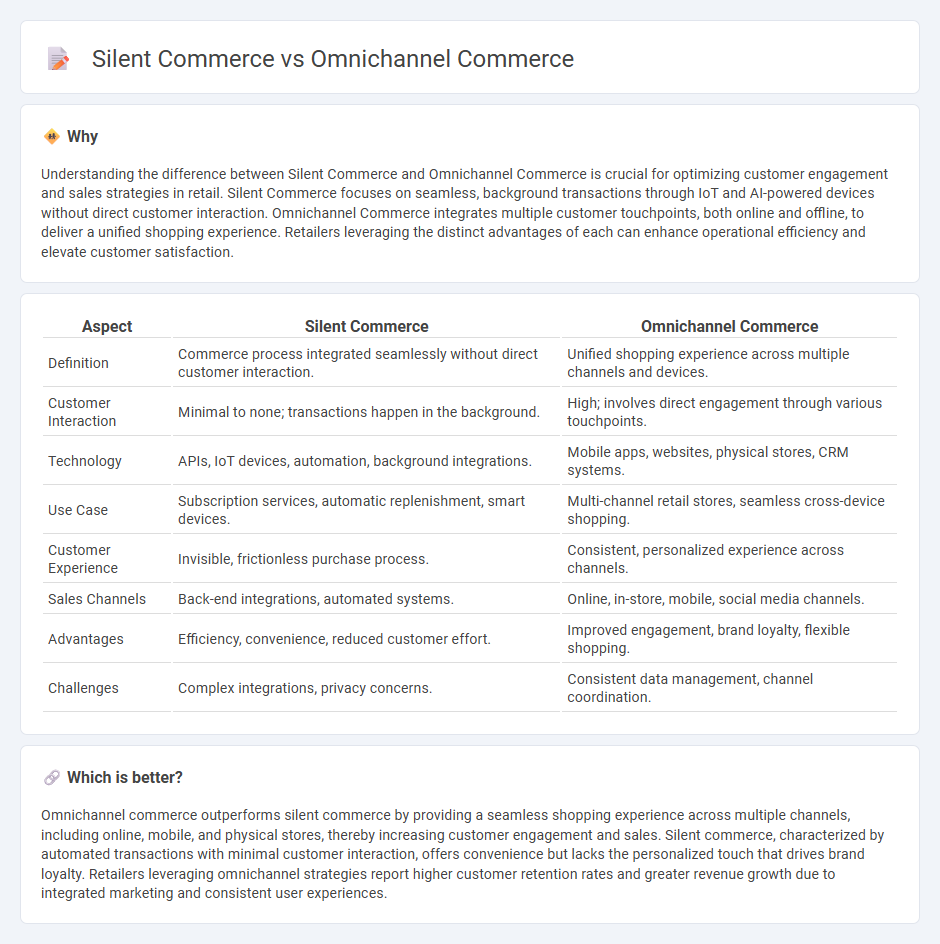
Silent commerce leverages background technologies like AI, IoT, and voice assistants to facilitate seamless, frictionless shopping experiences without explicit user interactions. In contrast, omnichannel commerce integrates multiple sales channels--online, mobile, and physical stores--to provide a unified and consistent customer journey. Explore how these innovative retail strategies are reshaping consumer engagement and driving sales growth.
Why it is important
Understanding the difference between Silent Commerce and Omnichannel Commerce is crucial for optimizing customer engagement and sales strategies in retail. Silent Commerce focuses on seamless, background transactions through IoT and AI-powered devices without direct customer interaction. Omnichannel Commerce integrates multiple customer touchpoints, both online and offline, to deliver a unified shopping experience. Retailers leveraging the distinct advantages of each can enhance operational efficiency and elevate customer satisfaction.
Comparison Table
| Aspect | Silent Commerce | Omnichannel Commerce |
|---|---|---|
| Definition | Commerce process integrated seamlessly without direct customer interaction. | Unified shopping experience across multiple channels and devices. |
| Customer Interaction | Minimal to none; transactions happen in the background. | High; involves direct engagement through various touchpoints. |
| Technology | APIs, IoT devices, automation, background integrations. | Mobile apps, websites, physical stores, CRM systems. |
| Use Case | Subscription services, automatic replenishment, smart devices. | Multi-channel retail stores, seamless cross-device shopping. |
| Customer Experience | Invisible, frictionless purchase process. | Consistent, personalized experience across channels. |
| Sales Channels | Back-end integrations, automated systems. | Online, in-store, mobile, social media channels. |
| Advantages | Efficiency, convenience, reduced customer effort. | Improved engagement, brand loyalty, flexible shopping. |
| Challenges | Complex integrations, privacy concerns. | Consistent data management, channel coordination. |
Which is better?
Omnichannel commerce outperforms silent commerce by providing a seamless shopping experience across multiple channels, including online, mobile, and physical stores, thereby increasing customer engagement and sales. Silent commerce, characterized by automated transactions with minimal customer interaction, offers convenience but lacks the personalized touch that drives brand loyalty. Retailers leveraging omnichannel strategies report higher customer retention rates and greater revenue growth due to integrated marketing and consistent user experiences.
Connection
Silent commerce leverages seamless, automated transactions embedded within everyday devices and environments, enhancing the omnichannel commerce experience by creating frictionless purchasing opportunities across multiple touchpoints. By integrating silent commerce technologies such as IoT-enabled devices and voice assistants, retailers can deliver consistent, personalized shopping experiences that unify online, mobile, and in-store interactions. This synergy improves customer engagement, increases conversion rates, and drives revenue growth within omnichannel retail strategies.
Key Terms
**Omnichannel Commerce:**
Omnichannel commerce integrates multiple retail channels such as physical stores, e-commerce platforms, social media, and mobile apps to provide seamless, personalized customer experiences across all touchpoints. This approach leverages real-time data synchronization, ensuring consistent pricing, inventory visibility, and customer engagement regardless of the channel used. Explore how omnichannel commerce transforms retail strategies and enhances customer satisfaction for more insights.
Customer Experience
Omnichannel commerce integrates multiple customer touchpoints across online and offline channels, ensuring a seamless and consistent shopping experience that enhances customer satisfaction and loyalty. Silent commerce leverages AI, IoT, and voice technology to enable frictionless, background transactions without direct customer interaction, optimizing convenience and personalization. Explore how these innovative strategies reshape customer experience and boost business growth.
Integration
Omnichannel commerce integrates multiple sales channels, including physical stores, online platforms, and mobile apps, creating a seamless customer experience and consistent brand interaction. Silent commerce leverages background technologies such as IoT devices and voice assistants to enable transactions without explicit customer input, emphasizing automation and frictionless purchasing. Discover how integration strategies differ between omnichannel and silent commerce to boost customer engagement and operational efficiency.
Source and External Links
Comprehensive Guide for Omnichannel Retail Success for 2025 - Offers insights into how omnichannel retail integrates various shopping channels for a seamless customer experience, enhancing business operations and customer satisfaction.
What Is Omnichannel Retail? How it Works and Examples - Provides a detailed explanation of omnichannel retailing, highlighting its importance in creating a unified shopping experience across multiple channels.
What is Omnichannel ecommerce? - Defines omnichannel e-commerce as an approach that unifies customer experiences across various digital and physical channels, ensuring a seamless interaction with brands.
 dowidth.com
dowidth.com